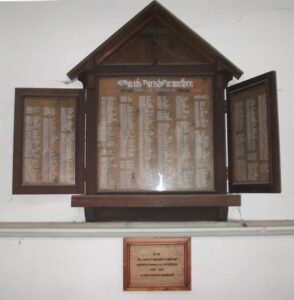Christ Church was built to cater for the English-speaking population of St David’s Parish, in Carmarthen and is situated at the top of Lammas Street, on the corner of Morfa Lane, opposite Carmarthen Quins Rugby Club and the entrance to Carmarthen Park. Inside the Church is a brass memorial plaque, which is inscribed with the names of the 36 members of the Parish of St David’s who fell during the Great War. The memorial was unveiled in a service on 18 September 1921, by Major-General F Ramsay, and was dedicated by Bishop John Owen of St. David’s, who had himself lost a nephew during the war. Within the now closed St David’s Church is a wooden ‘war shrine’ which contains the names of all of the St. David’s Parishioners who served during the Great War. (see the foot of this page).
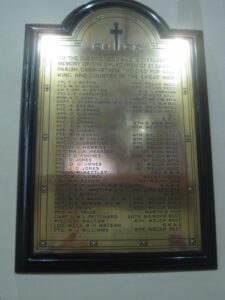
The Great War, 1914-1918
Thomas John Bowen, Corporal, 200942, Welsh Regiment. Thomas was the son of Thomas and Elizabeth Bowen, of Carmarthen. He enlisted there into the 1/4th Battalion, Welsh Regiment. On 4 August 1914 the Battalion formed at Carmarthen, as part of South Wales Brigade, Army Troops, then joined 159 Brigade, 53rd (Welsh) Division, before sailing from Devonport on 19 July 1915 for Mudros. From here the Division was landed at Suvla Bay on 9 August. Here they were plunged into the thick of the fighting and suffered terrible casualties over the coming months. Thomas was captured by the Turks at Gallipoli, and was sent to a POW Camp at Damascus, where the British POW’s were used as forced labour. Thomas died of sickness in captivity on 9 May 1917, and is buried at Damascus Commonwealth War Cemetery, Syria. His brother, William Henry Bowen, was taken prisoner at the same time, and died in captivity on 2 April 1917.
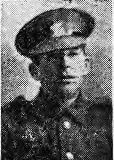
William Bowen, Chief Stoker, 276237, Royal Navy. William was born in Carmarthen on 8 March 1873, the son of George and Mary Bowen, of 86, Priory Street, Carmarthen. He enlisted into the Royal Navy several years prior to the war, and was married to Amelia Bowen, of Whitfield Farm, Poundbury, Dorchester, Dorset. At the outbreak of war William served aboard HMS Amphion, which was an ‘Active Class’ Cruiser, that had been built at Pembroke Dockyard. In the afternoon of 5 August 1914, Amphion, with the Third Flotilla, chased down a suspicious boat, which had been spotted throwing things overboard. This ship turned out to be a German Minelayer, and she was chased and sunk by the Flotilla. They then raced to intercept another suspicious ship, which turned out to be the St. Petersburg, which was carrying the German Ambassador back to Germany from England. The Flotilla moved back to their search area, and at 6.30 am Amphion struck one of the mines that had been laid by the German Minelayer. Badly damaged, and with heavy casualties onboard, Amphion stopped, and the escorting destroyers closed in and took off her surviving crew. The current carried her back into the minefield, and just three minutes after the last boatload of survivors were taken off, she again struck the same row of mines, and exploded, with debris striking the rescue boats and destroyers, sinking within 15 minutes. Around 150 British sailors were killed in the sinking, as well as 18 of the crew rescued from the SMS Königin Luise. The war was only 36 hours old, and the Amphion had been the first Royal Naval Ship sunk. William was killed during the initial explosions, and is now remembered on the Plymouth Naval Memorial, Devon.
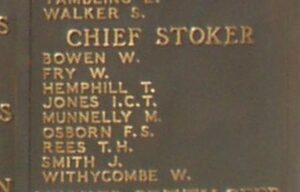
William Henry Bowen, Private, 200943, Welsh Regiment. William was the son of Thomas and Elizabeth Bowen of Carmarthen. He enlisted at Carmarthen into the 1/4th Battalion, Welsh Regiment. On 4 August 1914 the Battalion formed at Carmarthen, as part of South Wales Brigade, Army Troops, then joined 159 Brigade, 53rd (Welsh) Division, before sailing from Devonport on 19 July 1915 for Mudros. From here the Division was landed at Suvla Bay on 9 August. Here they were plunged into the thick of the fighting and suffered terrible casualties over the coming months. Thomas was captured by the Turks at Gallipoli, and was sent to a POW Camp at Damascus, where the British POW’s were used as forced labour. William died of sickness in captivity on 12 April 1917, aged just 20. He has no known grave, and so is remembered on the Jerusalem Memorial, Israel. His brother, Thomas John Bowen, was taken prisoner at the same time, and died in captivity on 9 May 1917.

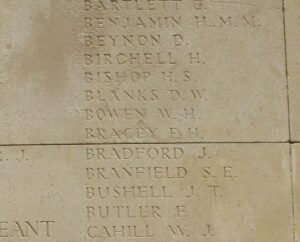
George Thomas Carpenter, Private, L/7233, Royal West Kent Regiment. George was born in Dalston, London on 6 October 1881, the son of Richard and Margaret Carpenter. He had enlisted at Stratford, London in March 1903 into the 1st Battalion, Royal West Kent Regiment, and served for several years in South Africa, before returning to Britain, where he married Miss Sage Richards, of Carmarthen, at Shoreditch on 8 April 1912. At the outbreak of the Great War, the 1st Royal West Kent’s were attached to 13 Brigade, 5th Division and moved to France, landing at Havre on 15 August 1914. They fought at the Battle of Mons, and during the retreat south, fighting at Le Cateau, then down to the Marne where the German attack was halted. They took part in the push back to the Aisne, before moving to Flanders, where they fought at the Battle of La Bassée, where George was wounded. George died of wounds on 27 October 1914 and is buried at Bethune Town Cemetery, France.
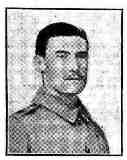
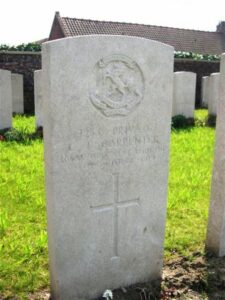
Arthur Trevor Cooke, Rifleman, 556802, London Regiment. Arthur was the son of Charles Alfred and Annie Cooke, of 52, Lammas Street, Carmarthen. He worked at Westcliffe-on-Sea, and enlisted there into the 2/11th Battalion (Finsbury Rifles), London Regiment, which was attached to 175 Brigade, 58th (2/1st London) Division. On 4 February 1917 the Battalion landed at Havre, and followed the German Retreat to the Hindenburg Line in March. They then took part in the Flanking Operations Round Bullecourt. Later that year they moved north to Ypres, and took part in the Battle of the Menin Road, the Battle of Polygon Wood and the Second Battle of Passchendaele. Arthur was killed in action when his battalion was moving into the line on 4 November 1917. He was 36 years old. A letter sent to his mother stated that Arthur had been buried where he fell, but his grave was lost during further fighting in the area, and Arthur is commemorated on the Tyne Cot Memorial, Belgium.
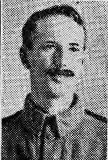
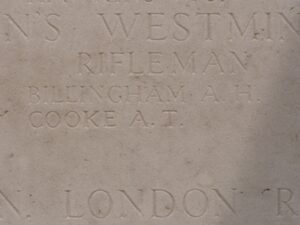
Lionel Gordon Crossman, Captain, Royal Army Medical Corps. Lionel was the son of John and Mary Crossman, of Ar-y-bryn, Carmarthen. He was educated at Queen Elizabeth Grammar School, Carmarthen, and at the Medical School, Cardiff University, where he obtained his B.Sc. degree (Wales) in 1910. He became a student at Bartholomew’s Hospital in 1910, and after graduating, was appointed house-physician to Dr James Calvert at St Bartholomew’s Hospital. Lionel gained a commission within the Royal Army Medical Corps, and joined the staff of the 1st London General Hospital. In 1916 he went to Mesopotamia serving under the rank of Captain, and joined the staff of the 40th British General Hospital, before being put in charge of the Pathological Laboratory. Lionel acquired a mild form of dysentery, which became complicated by pneumonia, and died of pleurisy and pneumonia on 11 December 1917, aged 29. Lionel is buried at Basra War Cemetery, Iraq.
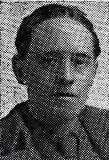
Thomas Henry Davies, Private, 47676, Northumberland Fusiliers. Thomas was born as Thomas Henry Davies on 4 April 1889, the illegitimate son of Caroline Davies. Caroline married his father, Thomas Price, on 14 September 1889, at Christ Church, Carmarthen. Thomas was raised as Thomas Henry Davies, at 13, Blue Street, Carmarthen. On 28 August 1912 he married Minnie Lewis at St. David’s Church, Carmarthen, and the couple set up home at 34, Hawkes Villas, Carmarthen. He enlisted at Carmarthen into the Royal Field Artillery under the name Thomas Henry Price, and was later transferred into the 21st Battalion (Tyneside Scots), Northumberland Fusiliers, which was attached to 102 Brigade, 34th Division. The Division moved to France between 7 and 15 January 1916, and saw its first major action on the Somme, during the Battle of Albert, where it suffered very severe casualties during its part in the attack on La Boiselle. It then took part in the Battle of Bazentin, Battle of Poziéres and the Battle of Flers-Courcelette. The following year saw them fighting at the Battle of Arras. Thomas was killed on 28 December 1917, and is buried at St. Martin Calvaire British Cemetery, St. Martin-Sur-Cojeul, France. His brother, Arthur James Price, also fell.
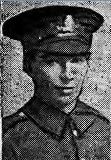
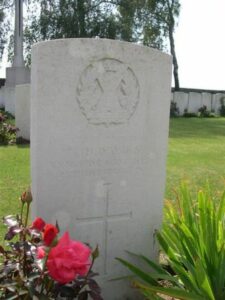
Arthur Howie Evans, Private, 288032, Welsh Regiment. Arthur was the son of David and Eliza Ann Evans, of 18, Parcmain Street, Carmarthen. He enlisted at Carmarthen into the Welsh Regiment, and saw action at Gallipoli, before being evacuated home suffering from frostbite and dysentery. He was then posted to the 6th Battalion, Welsh Regiment, which was the Pioneer Battalion to the 1st Division, and had been in France almost since the outbreak of war. The Division was stationed on the Flanders Coast. While training on the coast, the Battle of Third Ypres had stalled in the mire, and the Division were recalled to Ypres, where they fought at the Battle of Passchendaele. Arthur was wounded at Ypres, and brought back to a Casualty Clearing Station near Proven, where he died of wounds on 24 October 1917. He was 21 years old, and is buried at Dozinghem Military Cemetery. His brothers William Archibald Evans and David George Evans also fell.

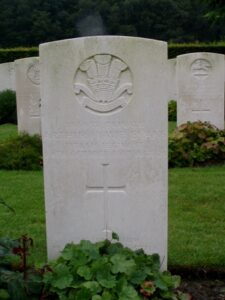
David George Evans, Sapper, 79487, Royal Engineers. David was the son of David and Eliza Ann Evans, of 18, Parcmain Street, Carmarthen. He originally enlisted at Pentre into the Dorsetshire Regiment, moving to France soon after the outbreak of war, butwas wounded by shrapnel and hospitalised. David was later transferred into the Royal Engineers, where he was attached to their 174th Tunnelling Company. The Company was on the Somme from mid 1916 onwards, and after the Somme Offensive had been closed down, were in the Beaumont Hamel area. David was killed in action here by heavy German shellfire on 24 August 1917, aged 38, and is buried at Croisilles British Cemetery, France. His brothers Arthur Howie Evans and William Archibald Evans also fell.

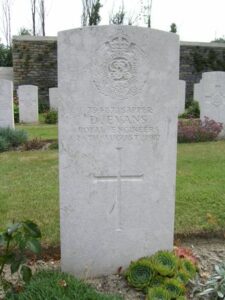
Henry Evans, Gunner, 42398, Royal Garrison Artillery. Henry was the son of John and Sarah Evans, of 3, Glannant Road, Carmarthen. He enlisted at Carmarthen into the Royal Garrison Artillery, but sadly died of tuberculosis before being posted to a Battery, on 23 June 1917. Henry was 25 years old, and is buried at Carmarthen (St. David) Churchyard.
Henry Thomas Evans, Private, 10863, Royal Warwickshire Regiment. Henry was the son of Elizabeth Evans, of Lower Brickyard, Carmarthen. He enlisted at Carmarthen into the Welsh Regiment, but was posted to the 9th Battalion, Royal Warwickshire Regiment, which was attached to 39 Brigade, 13th (Western) Division. On 13 June 1915 the first transports carrying the Division left port, and moved to Alexandria, then by 4 July, all units had moved to Mudros, preparatory for landing on Gallipoli over the coming days. Between 6 and 16 July 1915 the Division landed at Cape Helles and relieved the 29th Division. Henry was wounded on 8 July, and was evacuated to a Hospital Ship. He sadly died of wounds and was buried at sea on 20 July 1915 aged only 19. Henry is commemorated on the Helles Memorial, Gallipoli.

Richard Albert Evans, Sergeant, 200828, Welsh Regiment. Richard was the son of Thomas and Elizabeth Evans, of 29, Catherine Street, Carmarthen. He originally served with the 1/4th Battalion, Welsh Regiment, which was the local Territorial Battalion, attached to 159 Brigade, 53rd (Welsh) Division. He was the Regimental Shoe Maker in the battalion. The Division landed at Cape Helles, Gallipoli, on 9 August 1915, and was immediately thrown into action, spending the next few days in isolated pockets, fighting against a Turkish counter-attack during the Battle of Sari Bair, and then at the Attack on Scimitar Hill. The Division remained here throughout the coming months, and suffered severe losses in manpower strength during the great November 1915 blizzard on Gallipoli, when its total strength was reduced to less than that of a full-strength Brigade. On 11 December 1915 the Division was evacuated to Mudros, and by 23 December 1915 were moved to Egypt. They remained on the Suez Canal Defences for the next twelve months, where it took part in operations against the Sultan of Darfur, and in March 1917 took part in the advance into Palestine. On 30 July 1918 the 1/4th and 1/5th Welsh were again merged, forming the 4/5th Battalion and they remained in Palestine until leaving for the UK on 31 October 1918. Richard took ill whilst aboard ship, and sadly died of disease at home on 6 August 1919. The 27-year-old was buried in St. David’s Churchyard, Carmarthen on the following Saturday, 9 August.
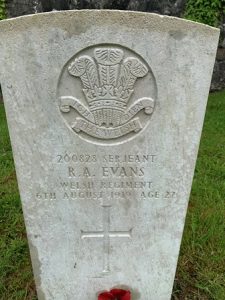
William Archibald Evans, Corporal, 13738, Welsh Regiment. William was the son of David and Eliza Ann Evans, of 18, Parcmain Street, Carmarthen. William enlisted at Swansea into the 9th Battalion, Welsh Regiment, who were attached to 58 Brigade, 19th (Western) Division. The Division assembled around Bulford during September 1914, and crossed to France during July 1915, moving to positions near Loos. The Division fought during the opening attack of the Battle of Loos. They remained in the area during the coming months, and this is where William was taken ill. He died of acute pneumonia on 8 March 1916 aged 31, and is buried at Merville Communal Cemetery. His brothers, Sapper David George Evans, and Private Arthur Howie Evans also fell.

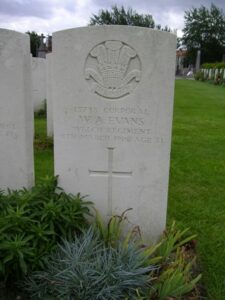
William Henry Evans, Private, 3968, Welsh Regiment. William was the son of Edward and Lizzie Jane Evans, of St. Catherine Street, Carmarthen. He enlisted there into the 1/4th Battalion, Welsh Regiment, which was the local Territorial Battalion, attached to 159 Brigade, 53rd (Welsh) Division. The Division landed at Cape Helles, Gallipoli, on 9 August 1915, and was immediately thrown into action, spending the next few days in isolated pockets, fighting against a Turkish counter-attack during the Battle of Sari Bair, and then at the Attack on Scimitar Hill. The Division remained here throughout the coming months, and suffered severe losses in manpower strength during the great November 1915 blizzard on Gallipoli, when its total strength was reduced to less than that of a full-strength Brigade. On 11 December 1915 the Division was evacuated to Mudros, and by 23 December 1915 were moved to Egypt. They remained on the Suez Canal Defences for the next twelve months, and this is where William was wounded. He was brought to Hospital in Alexandria for treatment, but sadly died there of wounds on 16 September 1915, aged 20. William is buried at Alexandria (Chatby) Military and War Memorial Cemetery, Egypt.

William James Cadwallader Evans, M.I.D., Sergeant, 448309, Royal Engineers. William was the son of Thomas and Mary Jane Evans, of 18, Mansel Street, Carmarthen. He served with the 1/1st Welsh Field Company, Royal Engineers, which was attached to the 53rd (Welsh) Division. William fought at Gallipoli, Egypt in Palestine during the war, and had been Mentioned in Dispatches. He died in Egypt on 15 November 1918, aged 31, and is buried at Alexandria (Hadra) War Memorial Cemetery, Egypt. William is also remembered on the Welsh Field Company, Royal Engineers Memorial in Carmarthen.
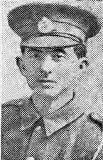
Cyril Mortimer Green, Captain, Royal Sussex Regiment. Cyril was the son of Thomas Mortimer Green and Catherine Green, of Aberystwyth, and the husband of Gwendoline Mortimer Green, of 23, Southwood Court, Golder’s Green, London. Cyril was a native of Denbigh, and had been educated at the University Colleges of Exeter, Carmarthen and Aberystwyth, along with his brother Hugh (see below), before being gazetted as Second Lieutenant into the 2nd Battalion, Royal Sussex Regiment in October 1914. Cyril served in France until he was severely wounded at Festubert on 9 May 1915, and returned home for treatment. Returning to the front, he was attached to the 16th Battalion, Royal Sussex Regiment, who were attached to 230 Brigade, 74th Division. The Division was taking part in the advance into Palestine, and had just successfully fought in the Third Battle of Gaza, when Cyril was killed in action on 6 November 1917. He was 29 years old, and is buried at Beersheba War Cemetery, Israel. Cyril is not commemorated on the Memorial Roll, although his brother Hugh is.
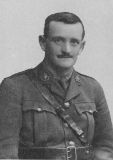
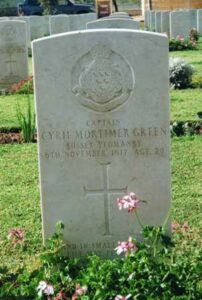
Hugh Mortimer Green, Captain, Welsh Regiment. Hugh was the son of Thomas Mortimer Green and Catherine Green, of Aberystwyth, and the Brother of Cyril Mortimer Green (see above). Hugh was educated at Carmarthen University along with Cyril, and was gazetted into the Welsh Regiment. He was posted to the 1/4th Battalion, Welsh Regiment, which was the local Territorial Battalion, attached to 159 Brigade, 53rd (Welsh) Division. The Division landed at Cape Helles, Gallipoli, on 9 August 1915, and was immediately thrown into action, spending the next few days in isolated pockets. Hugh was killed in action on 10 August 1915 at the Battle of Sari Bair (Attack on Scimitar Hill). He has no known grave, and so is remembered on the Helles Memorial, Gallipoli.
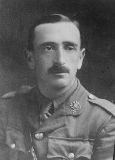
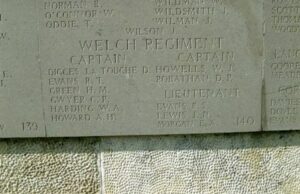
David Griffiths, Sergeant, 200715, Welsh Regiment. David was the son of John and Elizabeth Griffiths, of St. David’s Street, Carmarthen. He enlisted there into the 1/4th Battalion, Welsh Regiment, which was the local Territorial Battalion, attached to 159 Brigade, 53rd (Welsh) Division. The Division landed at Cape Helles, Gallipoli, on 9 August 1915, and was immediately thrown into action, spending the next few days in isolated pockets, fighting against a Turkish counter-attack during the Battle of Sari Bair, and then at the Attack on Scimitar Hill. The Division remained here throughout the coming months, and suffered severe losses in manpower strength during the great November 1915 blizzard on Gallipoli, when its total strength was reduced to less than that of a full-strength Brigade. On 11 December 1915 the Division was evacuated to Mudros, and by 23 December 1915 were moved to Egypt. They remained on the Suez Canal Defences for the next twelve months, where it took part in operations against the Sultan of Darfur, and in March 1917 took part in the advance into Palestine. David was killed in action soon after, during the First Battle of Gaza, on 26 March 1917, aged 34. He has no known grave, and so is remembered on the Jerusalem Memorial, Israel.
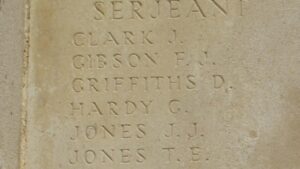
David John Harries, Private, 11212, Welsh Regiment. David was the son of John and Elizabeth Harris, of Swansea. He resided at 9, Blue Street, Carmarthen prior to enlisting before the war into the 2nd Battalion, Welsh Regiment. At the outbreak of war, the 2nd Welsh moved to France with 3 Brigade, 1st Division, and took part in the retreat from Mons to the Marne. It then fought at the First Battle of Ypres, where the 2nd Welsh made a gallant stand at Gheluvelt. The following year saw them in action again at the Battle of Aubers, before moving South to Loos, where they fought during the Battle of Loos, and the action at the Hohenzollern redoubt. David was killed while the 2nd Welsh were in the line at Loos on 15 May 1916. He was 22 years old, and is buried at Maroc British Cemetery, Grenay, France.
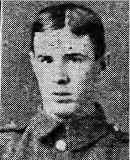
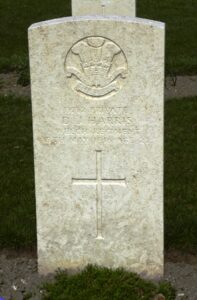
Kirk Hearder, Sergeant, 790, Monmouthshire Regiment. Kirk was born on 9 June 1883, the son of Dr. George Jonathan Hearder and Mrs. Marie Hearder, of 4, Picton Place, Carmarthen. He married Mary Louisa Weights, a Postmistress, at Newport in 1912, and the couple then lived at 83, Clevedon Road, Weston-super-Mare. Kirk was a Clerk at the National Provincial Bank at Newport, and enlisted there into the 1st Battalion, Monmouth Regiment, which were at Stow Hill, Newport as part of the Welsh Border Brigade, Welsh Division. During February 1915 the Battalion left the Welsh Division and landed in France on 13 February, attached to 84 Brigade, 28th Division. The Division saw its first major action at First Ypres in 1914. It was during the Second Battle of Ypres, that Kirk was killed in action, during the Battle of Frezenberg, on 8 May 1915. He was 31 years old, and is commemorated on the Ypres (Menin Gate) Memorial, Belgium. His brother, Major Dixon Hearder, served with the 11th Battalion, Australian Imperial Force.
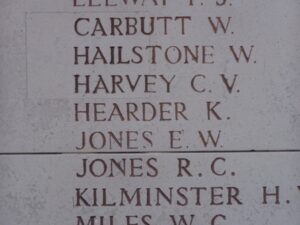
Frederick George Hughes, Private, 1934, Welsh Regiment. Frederick was born at Builth Road, Radnor, the son of Edward Morgan Hughes (Shipbroker), and Maria Hughes. The family moved to 4, Friar’s Park, Carmarthen prior to the war. Frederick had served for ten years with the Carmarthenshire Militia, and at the outbreak of war joined the 2nd Battalion, Welsh Regiment. The Battalion moved to France at the outbreak of war, attached to 3 Brigade, 1st Division, and had fought at the Battle of Mons, and took part in the retreat to the Marne, where the Germans were stopped. They then fought at the Aisne, and at Chivy, before being moved north to Ypres. Here they fought at the First Battle of Ypres, where they again stopped the German Offensive, before wintering in Flanders. The following year saw them in action again at the Battle of Aubers, before moving South to Loos, where they fought during the Battle of Loos, and the action at the Hohenzollern redoubt. Again they were required for a major offensive, moving south to the Somme, where they fought during the opening of the Somme Offensive. Frederick was severely wounded during the Battle of Pozieres, on 27 July 1916, and was brought back to Albert where he died that day. He was 39 years old, and is buried at Albert Communal Cemetery Extension, France.
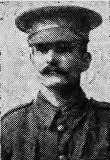
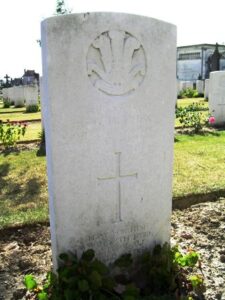
David Jones, Rifleman, 292, Rifle Brigade. David was the son of John and Frances Jones, of 18, Magazine Row, Carmarthen. He worked as a Postman at St. Clears prior to the war, and had served with the Army for several years prior to the war, having enlisted at Carmarthen. At the outbreak of war, he moved to France with the 1st Battalion, Rifle Brigade, part of 11 Brigade, 4th Division, and took part in the Battle of the Aisne. The Division then moved north to Ypres, where it took part in the First Battle of Ypres. David was killed in action whilst the Division was holding the line at Ploegsteert on 19 December 1914, aged 29. He is buried at Rifle House Cemetery inside Ploegsteert Wood. A letter was found in his tunic pocket, which was unfinished, and that he was going to send to Reverend Griffith Thomas, of St. David’s Church. This was forwarded on to his family after his burial, and told of his experiences at the front.
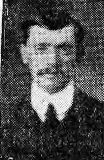
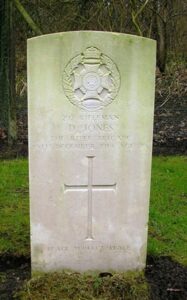
David George Jones, Private, 970, Welsh Regiment. David was the son of George and Sophia Jones, of 4, Shaws Lane, Carmarthen. He served prior to the war, having enlisted at Carmarthen into the 2nd Battalion, Welsh Regiment. The Battalion moved to France at the outbreak of war, attached to 3 Brigade, 1st Division, and had fought at the Battle of Mons, and the retreat to the Marne, where the Germans were stopped. They then fought at the Aisne, and at Chivy. David was killed in action at Chivy, during the same action that saw William Fuller of the 2nd Welsh win the first Welsh V.C. of the war, on 26 September 1914. His remains were never found, so David is commemorated on the La Ferté-Sous-Jouarre Memorial, France. His brother John Daniel Jones also fell.
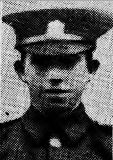
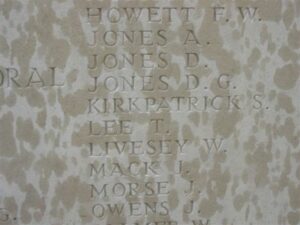
John Daniel Jones, Private, 1210, Welsh Regiment. John was the son of George and Sophia Jones, of 4, Shaws Lane, Carmarthen. He enlisted at Carmarthen into the 1st Battalion, Welsh Regiment, who were stationed in India at the outbreak of war. They were rushed back to the UK, where they joined 84 Brigade, 28th Division and landed at Havre on 18 January 1915. They moved into positions near Ypres, where they took part in the Second Battle of Ypres, and remained here during the following months, defending the Salient against further German attacks. John was killed in action at Ypres on 5 September 1915. He was only 18 years old, and is buried at Kemmel Chateau Military Cemetery, Belgium. His brother David George Jones also fell.

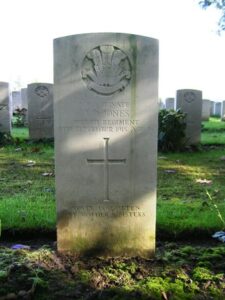
Archibald Walter Kettley, Private, 39521, South Wales Borderers. Archibald was the son of John and Mary Kettley, of 24, Parcmain Street, Carmarthen. He enlisted at Abertillery into the Monmouth Regiment, but later transferred into the 2nd Battalion, South Wales Borderers. The Battalion had begun the war in China, and had defeated the German garrison at Tientsin, before taking part in the Gallipoli campaign, attached to 87 Brigade, 29th Division. They remained there until evacuation to Egypt on 11 January 1916 and then moved to the Western Front on 15 March 1916. The Division took part in its first major action in France during the 1916 Somme Offensive, and fought at the Battles of Albert and Le Transloy, suffering heavy casualties. In the spring of 1917 they fought at the Battle of the Scarpe, which was part of the Arras Offensive, and then moved further north to Ypres. Here they fought at the Battle of Langemarck, and this is where Archibald was killed in action on 16 August 1917. He was 28 years old, and is commemorated on the Tyne Cot Memorial, Belgium.


William Cooper Lewis, Private, 137, Welsh Horse. William was the son of William and Sophia Lewis, of Carmarthen. He married Rhoda Jane Edwards, of St. Catherine Street, Carmarthen in 1910. William enlisted at Cardiff into the 1/1st Battalion, Welsh Horse Yeomanry, which moved early 1915 to the 1/1st North Midland Mounted Brigade of 1st Mounted Division in the Diss area of Norfolk. During September 1915 the Battalion dismounted and sailed from Liverpool in the SS Olympic on 25 September, landing at Anzac Cove, Gallipoli on 10 October 1915. The Welsh Horse were utilised as miners during their stint at Gallipoli, and it was during the explosion of a Turkish Mine on 20 November 1915 that William was killed. He was 34 years old, and was buried at the 7th Field Ambulance Cemetery, Gallipoli. His grave was subsequently lost, and so he is remembered by a Special Memorial there. His widow Rhoda, who was left alone to raise their two young children, later remarried William Henry Langford in 1916, and moved to Yew Tree Cottage, Leaton Heath, Shrewsbury.

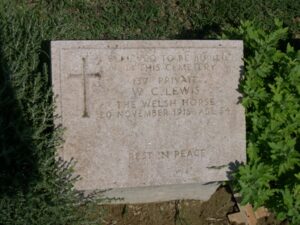
Walter Henry Lloyd, Captain, Royal Army Medical Corps. Walter was the son of Walter and Sarah Lloyd, of 12, Lammas Street, Carmarthen. He had trained as a Surgeon at London, gaining the M.B., and B.S., London, and had served at the Wandsworth Military Hospital for nine months, prior to volunteering to serve on the Western Front. He was commissioned as lieutenant in the 3rd London General Hospital in August 1915, and in June 1916, went to France as a Captain, serving as surgeon to a casualty clearing station with the Royal Army Medical Corps, attached to the 1/20th Battalion, London Regiment. The battalion was attached to 5 Brigade, 2nd (London) Division. The division was on the Somme throughout the summer of 1918, and it was here that Walter was killed on 4 August 1918. He was 27 years old and is buried at Contay British Cemetery, France.
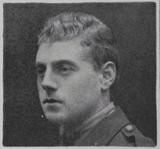
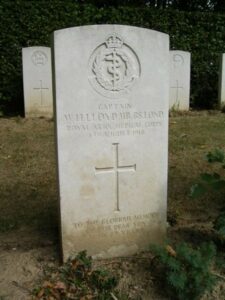
William Goater Lloyd, Lance Corporal, 731, Welsh Guards. William was the son of Richard and Elizabeth Lloyd, of St. Peter’s, Carmarthen. He enlisted there into the 1st Battalion, Welsh Guards, who had been raised by Royal Warrant of 26 February 1915, and formed at White City. On 18 August 1915 they landed at Havre, attached to 3rd Guards Brigade, Guards Division. This new Division saw its first major action during the Battle of Loos on 25 September 1915, remaining in the area during the coming months, where they also fought in the subsequent Action of Hohenzollern Redoubt. In July 1916 the Division moved to the Somme, where they fought at the Battle of Flers-Courcelette, and then at the Battle of Morval, capturing Lesboeufs Village. William was killed in action here on 24 September 1916, aged 20. He is commemorated on the Thiepval Memorial, France.
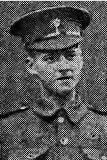
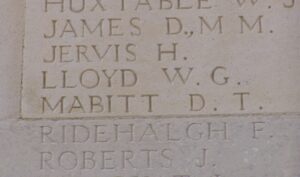
Wallis Austin Jonathan Marsden, Lieutenant, Royal Field Artillery. Wallis was the eldest son of the Rev. Jonathan Marsden and Emmeline Marsden, of Llanllwch. He was commissioned into the Territorials prior to the war, and was posted to France with the 2nd London Brigade, Royal Field Artillery. Wallis was wounded during the Battle of the Somme, on 21 September 1916, and was brought back to England for treatment at the Empire Hospital, Westminster. He died of his wounds on 20 July 1917 and was brought home for burial at Llanllwch (St. Luke) Churchyard.
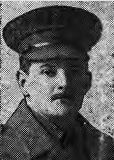
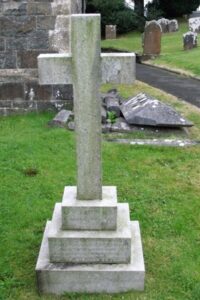
James John Morris, Private, 268205, Royal Welsh Fusiliers. James was the son of James and Jane Morris, of 46, Catherine Street, Carmarthen. He enlisted on 7 January 1915 into the Welsh Regiment, and was posted to the 1/4th Welsh, taking part in the Gallipoli campaign. James was wounded at Gallipoli, and was hospitalised at Cairo before rejoining the battalion at Gallipoli. He then became ill, suffering from exposure and dysentery, and was again evacuated to Egypt. He returned to England on 5 August 1916, and upon recover was transferred into the 9th Battalion, Royal Welsh Fusiliers on 9 April 1918, who were attached to 58 Brigade, 19th (Western) Division. The Division had been in France since July 1915. James joined them in Flanders, where they were rebuilding after being decimated during the German offensive of 21 March 1918 onwards. The Division was caught up in a fresh German attack at Messines in April, and fought a heroic rearguard action over the coming weeks. James was wounded during this period, and died of wounds on 29 April 1918. James was only 19 years old at the time of his death, and had seen three years fighting. He is buried at Esquelbecq Military Cemetery, France.
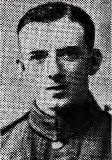
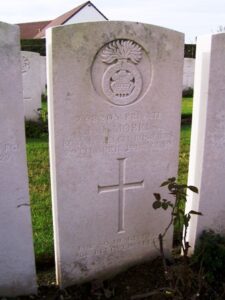
William Archibald Tucker Morris, DCM, Sergeant, 14582, Welsh Regiment. William was the son of Philip and Mary Morris, of Island Wharf, The Quay, Carmarthen. He was an old soldier, who had fought in the Boer War of 1899-1901, and at the outbreak of war went to France with the 2nd Battalion, Welsh Regiment, who were attached to 3 Brigade, 1st Division. William fought with the Division during the retreat from Mons to the Marne, where the Germans were stopped. After a famous action at Chivy sur Aisne, the 2nd Welsh moved to Ypres, and made a famous stand at Ghelulveldt during the First Battle of Ypres, where they again stopped the German Offensive. The following year saw them in action again at the Battle of Aubers, before taking part in the Battle of Loos, and the action at the Hohenzollern redoubt. In 1916 the Division moved south to the Somme, and fought at the Battles of Albert, Bazentin, Pozieres, Flers-Courcelette and Morval. William was awarded his Distinguished Conduct Medal for Gallantry on the Somme during the Battle of Pozieres, on 25 July 1916, when he remained at his post, although wounded, and helped repulse a German counter-attack. He returned home to Cambridge for treatment, and was presented with his medal in Hospital there. He refused to take up a post as an instructor after recovering, and instead returned to the 2nd Welsh, who had moved to the Flanders Coast during the summer of 1917, prior to taking part in the Second Battle of Passchendaele. After spending another winter in Flanders, they were near Estaires when the German Spring Offensive caught them, and William was severely wounded here. He was brought back to the UK for treatment at the 1st Southern General Military Hospital, Birmingham, but sadly died of wounds there on 2 May 1918. William was 38 years old, and was brought home for burial at Carmarthen (St. David) Churchyard.
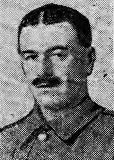
James Alexander Orman, DCM, Sergeant, 200780, Welsh Regiment. James was the son of James Henry and Emily Orman, of Southampton. He married Emma Jane Lewis in 1907, and the couple resided at 6, Glannant Road, Carmarthen. James enlisted at Carmarthen into the 1/4th Battalion, Welsh Regiment, which was the local Territorial Battalion, attached to 159 Brigade, 53rd (Welsh) Division. The Division landed at Cape Helles, Gallipoli, on 9 August 1915, and was immediately thrown into action, spending the next few days in isolated pockets, fighting against a Turkish counter-attack during the Battle of Sari Bair, and then at the Attack on Scimitar Hill. James won his Distinguished Conduct Medal at Gallipoli on 11 August 1915, ‘For conspicuous gallantry on 9th August 1915, near Anzac, when, although wounded early in the day, he remained with his Company until dark, displaying great courage and resource.’ On 11 December the Division left Gallipoli for Egypt, and spent the next twelve months in Egypt, before taking part in the invasion of Palestine the following year. They fought throughout the successful campaign in Palestine, capturing Jerusalem in December, 1917. They fought throughout the duration of the war in Palestine, and James was killed in action during further operations in the Jordan Valley, on 9 March 1918, aged 34. He is buried in Jerusalem War Cemetery, Israel.
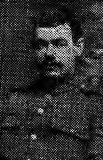
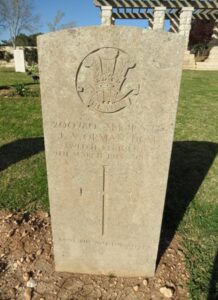
Arthur James Price, Private, 56908, Welsh Regiment. Arthur was the son of Thomas and Caroline Price, of 13, Blue Street, Carmarthen. He enlisted there into the Pembroke Yeomanry on 26 December 1915, and was posted to France on 5 August 1916, where he joined the 13th Battalion, Welsh Regiment. The battalion had just taken part in the capture of Mametz Wood while attached to 114 Brigade, 38th (Welsh) Division, and had just taken up positions at Boesinghe, north of Ypres. Arthur was wounded soon after, but quickly returned to duty. The Division remained here until the opening of the Passchendaele Offensive in July 1917, when it took part in the Battle of Pilckem Ridge on 31 July 1917. Arthur was killed in action during the subsequent Battle of Langemarck on 4 August 1917. He was 24 years old, and is commemorated on the Ypres (Menin Gate) Memorial, Belgium. His brother, Thomas Henry Price, also fell.
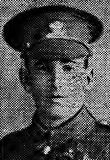
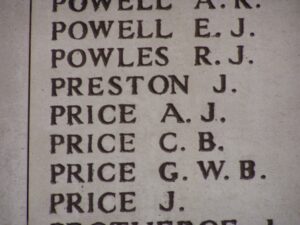
Gwynedd William Llewellyn Pritchard, MC, Captain, Manchester Regiment. Gwynedd was the son of William Jones Pritchard and Emily Caroline Pritchard, of 1, St. Clement’s Avenue, Bloxwich, Walsall, Staffs. He served with the 20th Battalion, Manchester Regiment, which had been in France since November 1915 with the 7th Division, and moved to Italy in November 1917. On 13 September 1918 they joined 7 Brigade, 25th Division in France, and took part in the final offensive. Gwynedd was sadly killed in action soon after arriving back in France, during the Battle of the Selle on 23 October 1918. He was 25 years old, and is buried at Pommereuil British Cemetery, France. Gwynedd was the holder of the Military Cross. The award was listed in the London Gazette of 7 March 1919, and read; ‘On 8th October, 1918, during the advance on Sonia Farm, he displayed great gallantry and initiative in handling his company. Troops on the right having lost direction and a gap resulting, he made good first Bronx Farm and later Foal Copse, the latter being strongly held by machine-guns, which would undoubtedly have held up the main advance on the left when it came to be proceeded with. He personally led his company in the attack on Foal Copse.’

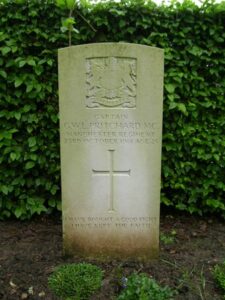
George Herbert Walton, Private, 200940, Welsh Regiment. George was the son of William Harrison Walton and Mary Walton, of 73A, Lammas Street, Carmarthen. He enlisted at Carmarthen on 1 November 1913 into the 4th Battalion, Welsh Regiment, which was the local Territorial battalion. George doesn’t seem to have served overseas, but took ill while in camp at Dale, and was discharged with a pension from the 4th Welsh as unfit on 13 September 1917. He died on 5 November 1918, aged 25, and is buried at Carmarthen (St. David) Churchyard.
Richard Henry Watson, Leading Mechanic, F/3307, Royal Naval Air Service. Richard was born in Hong Kong on 10 September 1895, the son of Henry J. Watson and Emmeline Watson. After his father’s death, Emmeline moved the family back to 47, Lammas Street, Carmarthen. Richard and his brother Arthur attended Carmarthen Grammar School prior to the war, and were both members of Carmarthen Harlequins Rugby Club. At the beginning of the war they both enlisted, and Richard joined the Royal Naval Air Service as a Mechanic. Richard was posted to the Dunkerque Air Station after training as a wireless operator, and in April 1917 a report appeared in the Carmarthen Journal that both brothers had been reported missing during that month. Arthur turned up as a Prisoner of War in Germany after having been shot down whilst serving with the Royal Flying Corps, but Richard was discovered to have been shot down whilst flying in a HP 0/100 off Nieuport, and taken prisoner. He died of wounds on 26 April 1917, aged just 22, and is commemorated on the Chatham Naval Memorial, Kent.
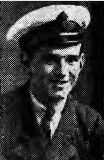
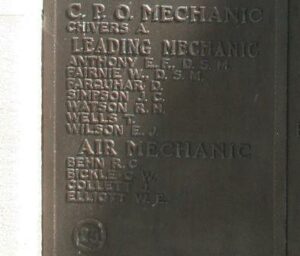
William John Williams, Private, 11669, Welsh Regiment. William was the son of John and Alice Williams, of 4, Woods Row, Carmarthen. He enlisted at Carmarthen into the 8th Battalion, Welsh Regiment, which was formed at Cardiff in August 1914, moving to Parkhouse, Salisbury Plain in 40 Brigade, 13th Division. In January 1915 they became the Pioneer Battalion to the 13th Division, and on 15 June 1915 sailed from Avonmouth for Mudros, landing at Anzac Cove, Gallipoli on 5 August 1915. The Division was plunged almost immediately into the Battle of Sari Bair, and this is where William was killed in action just days later, on 8 August 1915, aged 26. He has no known grave, and so is remembered on the Helles Memorial, Gallipoli.

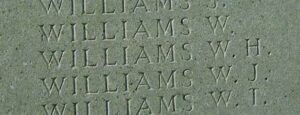
St. David’s Parishioners War Shrine
Within the now closed St. David’s Church is a fine wooden war-shrine’ which was originally dedicated in February 1917 to hold the names of all of the parishioners who served during the Great War. At the time of its dedication over 350 parishioners were serving out of a congregation of 2,000 people. I have not yet had the time to transcribe all of the names, but the shrine is pictured below. This memorial will have its own seperate page when I’ve transcribed it.
